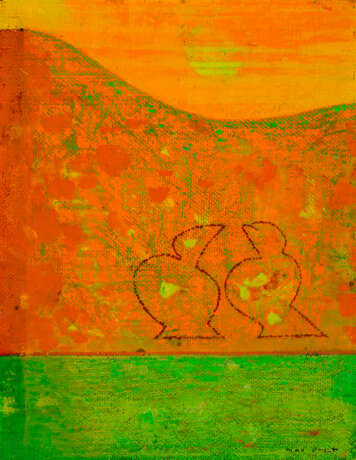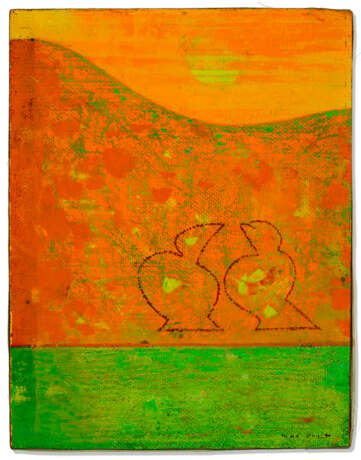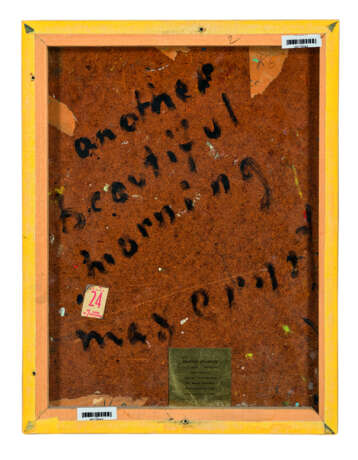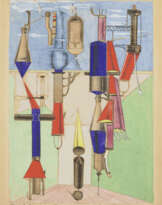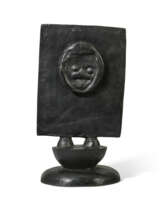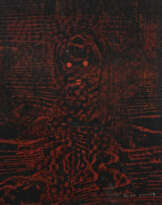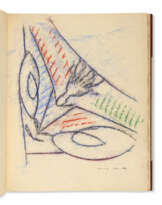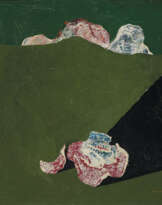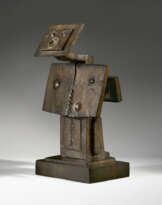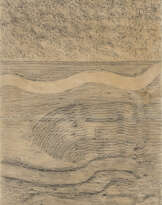ID 1400181
Лот 358 | Max Ernst (1891-1976)
Оценочная стоимость
€ 80 000 – 120 000
Another beautiful morning
signé 'max ernst' (en bas à droite); signé et inscrit 'another beautiful morning max ernst' (au revers)
huile sur Isorel
33.3 x 25.7 cm.
Peint vers 1953
signed 'max ernst' (lower right); signed and inscribed 'another beautiful morning max ernst' (on the reverse)
oil on Masonite
13 1/8 x 10 1/8 in.
Painted circa 1953
Provenance
The Mayor Gallery, Londres.
Aram Mouradian, Paris (avant 1974, probablement acquis auprès de celle-ci).
Collection particulière, France (avant 1998).
Puis par descendance au propriétaire actuel.
Literature
A. Bosquet, 'Le bonheur de Max Ernst', in Quadrum, Revue internationale d'art moderne, No. 5, Bruxelles, 1958, p. 18 (illustré en couleurs).
W. Spies, S. Metken et G. Metken, Max Ernst, Œuvre-Katalog, Werke 1939-1953, Cologne, 1987, p. 363, no. 3024 (illustré).
Further details
Peint vers 1953, cette vision éthérée dévoile un couple d’oiseaux dans une grande nébuleuse de peinture, leurs corps se chevauchant et s'entremêlant pour se faire une place au centre de la toile. Les volatiles ont toujours joué un rôle important dans la vie de l'artiste – Ernst admettait lui-même avoir fait, depuis son enfance, un rapprochement inconscient et persistant entre les oiseaux et les êtres humains.
La surface très travaillée de la présente œuvre constitue un parfait exemple des recherches que le peintre mène avec la technique quasi-automatique du « grattage ». Ici, des pigments versicolores ont été appliqués sur la surface par épaisses couches successives avant d'être délicatement raclés pour révéler les nuances des strates inférieures. Comme avec les « frottages » sur papier de ses années antérieures, les grains et les motifs ainsi exposés servent d'amorce à l'imagination et à la créativité toujours fécondes de l'artiste. La découverte de ces procédés est une véritable révélation : « Je fus surpris de l’intensification subite de mes facultés visionnaires et de la succession hallucinante d’images contradictoires, se superposant les unes aux autres avec la persistance et la rapidité qui sont le propre des souvenirs amoureux », se souvient-il (‘On Frottage’, 1936 in H. B. Chipp, Theories of Modern Art: A Source Book by Artists and Critics, Berkeley et Londres, 1968, p. 429).
Dans Another beautiful morning, Ernst sonde les possibilités expressives du grattage en jouant sur les textures de l'huile pour produire des impressions et des motifs inattendus. Posant d'abord l'huile sur une surface inégale, il s'applique ensuite à râper et gratter les pellicules de peinture jusqu'à l'obtention de riches sillons multicolores qui laissent entrevoir les saillies du support d'origine, tout en suggérant des formes entièrement nouvelles. Les empâtements denses conservent la trace des gestes de l'artiste à l'œuvre, les fines traînées de pigments indiquant le sens dans lequel il a fait glisser ses huiles de part et d'autre du tableau. En réponse aux empreintes et aux marques accidentelles qui émergent de ces frottements, Ernst retravaille ici sa composition pour y intégrer les silhouettes stylisées des oiseaux dont il varie les poses et les dimensions – certains déploient leurs ailes tandis que d'autres semblent se lisser les plumes ou guetter de nouveaux arrivants. Ernst empreint ainsi la scène d'une saisissante sensation de mouvement et d'énergie, donnant presque à entendre la cacophonie du grand rendez-vous des oiseaux.
Painted circa 1953, the present work presents an ethereal vision in which a plethora of birds converge in a great cloud of paint at the centre of the canvas, their bodies overlapping and intertwining as they jostle for space. Birds had always played a significant role in the artist’s life – since childhood, as Ernst himself explained, he had made a clear unconscious connection in his mind between people and birds.
The highly worked surface is an example of the artist’s earliest experiments with the semi-automatic technique of grattage, as a series of multicoloured pigments are placed in thick, consecutive layers on the canvas, then gently scraped away to reveal the underlying hues and layers. Exposing grains and patterns that, as in his earlier graphic frottage rubbings, subsequently served as prompts for his ever-fertile imagination and creativity. ‘I was surprised by the sudden intensification of my visionary capacities and by the hallucinatory succession of contradictory images superimposed, one upon the other, with the persistence and rapidity characteristic of amorous memories,’ he recalled about the revelation these techniques brought to his working practice. (‘On Frottage’, 1936; in H. B. Chipp, Theories of Modern Art: A Source Book by Artists and Critics, Berkeley and London, 1968, p. 429).
In Another beautiful morning, Ernst delves into the expressive possibilities of grattage, playing with the materiality of the oil paint to produce unexpected patterns and impressions. Laying the oil over a textured surface, he scraped and scratched the layers of paint away to reveal rich, multi-coloured patterns which both echo the underlying material used in their creation and suggest entirely new forms. The heavily impastoed paint retains traces of the artist’s movements as he worked, with thin lines of pooled pigment indicating the path and direction in which he dragged the oils across the surface of the canvas. Responding to the unexpected marks and shapes that emerged from the scrapings, the artist then worked back into the painting, adding the simplified outlines of the birds in a variety of sizes and poses – some spread their wings to their full expanse, while others appear to preen their feathers, or glance around at another new arrival. In this way, Ernst imbues the scene with an incredible sense of movement and energy, almost conjuring an impression of the great cacophony of sound that would have accompanied the crowd of birds as they gathered.
| Автор: | Макс Эрнст (1891 - 1976) |
|---|---|
| Техника исполнения: | Масло, Расписанный |
| Место происхождения: | Западная Европа, Германия, Европа |
| Категория аукционного дома: | Картины, Акварели, Рисунки, Картины |
| Автор: | Макс Эрнст (1891 - 1976) |
|---|---|
| Техника исполнения: | Масло, Расписанный |
| Место происхождения: | Западная Европа, Германия, Европа |
| Категория аукционного дома: | Картины, Акварели, Рисунки, Картины |
| Адрес торгов |
CHRISTIE'S 8 King Street, St. James's SW1Y 6QT London Великобритания | |
|---|---|---|
| Предосмотр |
| |
| Телефон | +44 (0)20 7839 9060 | |
| Комиссия | see on Website | |
| Условия использования | Условия использования |
